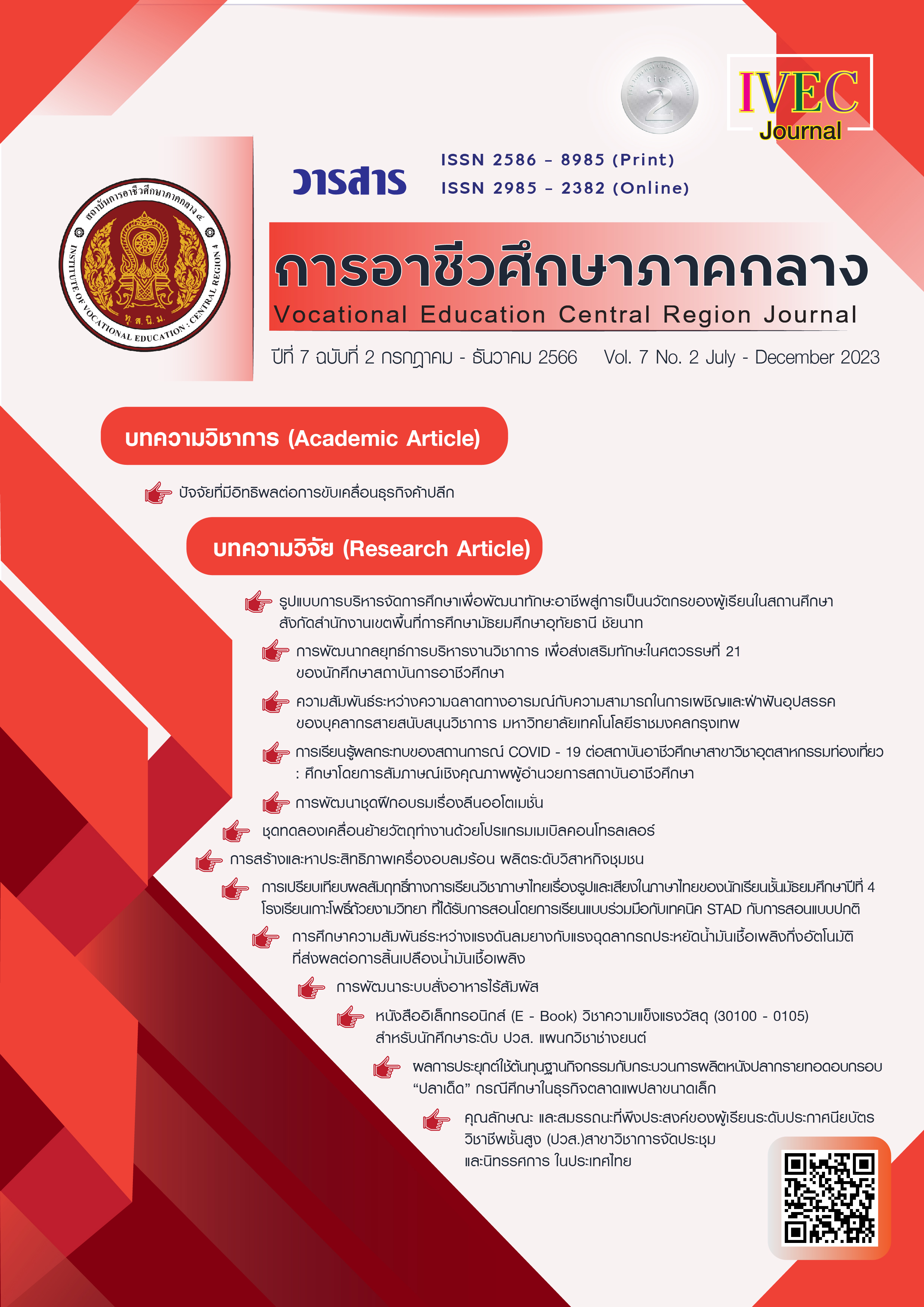Construction and Efficiency Determination of Hot Air Dryer Community Enterprise Level Production
Main Article Content
Abstract
The objectives of this research were 1) to construct a hot air dryer. For drying materials such as fruits and herbs produced at the community enterprise level, and 2) studying the performance of a hot air dryer by drying mango pulp the design of the researcher used A stainless steel construction material nd selected gas (LPG) for heat generation. And uses A 18 - inch impeller fan driven by a 1/3 - horsepower motor, using an axial - flow installation principle which is characterized by low wind power to circulate heat and vent moisture well the temperature can be controlled at 40 - 80 °C with a digital display electronic system that is easy to use. In the experiment, the mango stir - fry was baked at 40, 50, 60, and 70 °C, respectively. The experiment was repeated 3 times to find the mean. The research results showed that 1) The result from the mango preserve drying experiment was able to pack more than 100 kilograms of mango preserves / time. It meets the needs of community enterprises and 2) the performance of the hot air dryer takes an average drying time of 4 hours with a temperature of 60 degrees. Analysis of the break - even point in engineering economics. The cost of building a hot air dryer is 200,000 baht, with variable costs such as the cost of drying mangoes equal to 1.8575 baht / kg. The production capacity of the hot air dryer can produce 200 kg per time, 4 hours at a cost of 75 baht / kg. 150 baht per unit, it was found that the break - even point was 2,667 kilograms. The payback period of the hot air dryer Able to pay back the investment within 7 days
Article Details

This work is licensed under a Creative Commons Attribution-NonCommercial-NoDerivatives 4.0 International License.
|
บทความ ข้อมูล เนื้อหา รูปภาพ ฯลฯ ที่ได้รับการตีพิมพ์ในวารสาร การอาชีวศึกษาภาคกลาง ถือเป็นลิขสิทธิ์ของวารสารการอาชีวศึกษาภาคกลางหากบุคคลหรือหน่วยงานใดต้องการนำทั้งหมดหรือส่วนใดส่วนหนึ่ง ไปเผยแพร่ต่อหรือเพื่อกระทำการใด ๆ กองบรรณาธิการไม่สงวนสิทธิ์ ในการคัดลอกบทความเพื่อการศึกษาแต่ให้อ้างอิงแหล่งที่มาให้ครบถ้วน สมบูรณ์ สงวนสิทธิ์ โดย สถาบันการอาชีวศึกษาภาคกลาง 4 ที่ตั้ง 90 ถนนเทศา ตำบลพระปฐมเจดีย์ อำเภอเมือง จังหวัดนครปฐม โทรศัพท์ 034 242 856 , โทรสาร 034 242 858 ISSN : 3056-9176 (print) ISSN : 2985-2382 (online) |
References
กฤษฎางค์ ศุกระมูล, สัญลักษณ์ กิ่งทอง, จรุญ แก่นจันทร์, สถาปัตย์ ชะนากลาง, และมนัญญา คําวชิระพิทักษ์. (2021). การพัฒนาเครื่องอบแห้งพลังงานแสงอาทิตย์แบบตากแห้งโดยตรงสำหรับอบแห้งกล้วยน้ำว้าใช้ในระดับชุมชน. วารสารวิชาการเทคโนโลยีอุตสาหกรรม : มหาวิทยาลัยราชภัฏสวนสุนันทา, 9, (1), หน้า 38 - 48.
กฤษณ์ สงวนพวก. (2019, January - June). กิจกรรมการต้านอนุมูลอิสระ ปริมาณเบต้าแคโรทีน ไลโคพีน และฟลาโวนอยด์ของมะม่วงรับประทานดิบสายพันธุ์พื้นบ้านในประเทศไทยหลังการเก็บเกี่ยว. วารสารวิจัย มทร. กรุงเทพ, 13, (1), หน้า 68 - 81.
กิตติเชษฐ์ สุวรรณวัฒน์, พัชราภรณ์ ญาณภิรัต, และ ศันสนีย์ สุภาภา. (2561). การออกแบบใบพัดลมระบายความร้อนแบบไหลตามแนวแกนแบบสามใบพัดสำหรับเครื่องปรับอากาศโดยวิธีการออกแบบการทดลอง. ในการประชุมทางวิชาการของมหาวิทยาลัยเกษตรศาสตร์ ครั้งที่ 56 (30 มกราคม - 2 กุมภาพันธ์ หน้า 171 - 180). กรุงเทพฯ : สำนักงานกองทุนสนับสนุนการวิจัย.
ชญานิศ รัตนมงคล. (2561). จลนพลศาสตร์การอบแห้งมะม่วงด้วยสุญญากาศร่วมกับอินฟราเรดไกล.วิทยานิพนธ์ ปริญญาวิศวกรรมศาสตร์มหาบัณฑิต สาขาวิชาวิศวกรรมอาหารบัณฑิตวิทยาลัย มหาวิทยาลัยแม่โจ้.
ณัฐพร นันทจิระพงศ์, สุภา ศิรินาม, และรังสรรค์ โกญจนาทนิกร. (2562 , กรกฎาคม - ธันวาคม). ปัจจัยที่มีผลต่อคุณภาพของปลา สลิดแดดเดียวที่ตากด้วยตู้อบแห้ง. วารสารวิทยาศาสตร์และเทคโนโลยีหัวเฉียวเฉลิมพระเกียรติ, 5, (2), หน้า 72 - 83.
รุ่งโรจน์ ตับกลาง, บุณฑริกา สุมะนา, และวรรณศิริ หิรัญเกิด. (2564, มกราคม - มิถุนายน). ผลของอุณหภูมิและเวลาทำแห้งต่อคุณภาพของผลิตภัณฑ์กระท้อนแช่อิ่มอบแห้ง. วารสารวิจัยมหาวิทยาลัยเทคโนโลยีราชมงคลตะวันออก, 14, (1), หน้า 1 - 11.
วีระ ศรีอริยะกุล. (2564). การอบแห้งมะม่วงน้าดอกไม้โดยใช้การแผ่รังสีอินฟราเรดไกลร่วมกับอากาศร้อน. วารสารวิชาการเทคโนโลยีอุตสาหกรรม, 17, (3), หน้า 169 - 182.
สมศักดิ์ คำมา. (2561, มกราคม – มิถุนายน). การออกแบบและสร้างเครื่องสับย่อยเศษพืชผักในครัวเรือน. วารสารวิชาการคณะเทคโนโลยีอุตสาหกรรม มหาวิทยาลัยราชภัฏลำปาง, 11, (1), หน้า 82 - 95.
เอกกฤษ แก้วเจริญ และเอกภูมิ บุญธรรม. (2561, พฤษภาคม - ตุลาคม). ผลของความเร็วลมต่อประสิทธิภาพของเครื่องอบแห้งแบบปั๊มความร้อน. วารสารมหาวิทยาลัยทักษิณ, 21, (3 ฉบับพิเศษ), หน้า 158 - 166.
Czwielong, F., Floss, S., Kaltenbacher, M., & Becker, S. (2021, March). Influence of a micro - perforated duct absorber on sound emission and performance of axial fans. JournalApplied Acoustics, 174.


